On our way back from Colorado last month, Claudia and I spent a couple of nights in southern Utah. We had dinner with one of Utah’s most talented and thoughtful photographers, Guy Tal, along with his wife Sarah. (If you’re not familiar with Guy’s photography and writing you should be!) And we enjoyed the change in scenery, going from the forested, snowy mountains of Colorado to the red-rock canyons.
On our first afternoon in Utah some thunderstorms rolled through, forming interesting cloud patterns and dropping enough rain to create some mist and low clouds the next morning. Then the sun came out, but in the canyon country that’s just fine. In fact it’s great, because sunlight bouncing off the red canyon walls creates some beautiful lighting effects in the shade below – especially if there’s a creek or river, where you can find golden reflections in the water.
I love the canyon country. Our brief stop last month was way too short, so I’ll be back soon.
— Michael Frye
P.S. Just a quick reminder that our print sale ends on Friday, November 16th. Until then you can get 25% off on three of my most popular images. Click here to see all the details.
Related Posts: Aspen Pilgrimage; The Fate of our National Monuments
Michael Frye is a professional photographer specializing in landscapes and nature. He is the author or principal photographer of The Photographer’s Guide to Yosemite, Yosemite Meditations, Yosemite Meditations for Women, Yosemite Meditations for Adventurers, and Digital Landscape Photography: In the Footsteps of Ansel Adams and the Great Masters. He has also written three eBooks: Light & Land: Landscapes in the Digital Darkroom, Exposure for Outdoor Photography, and Landscapes in Lightroom: The Essential Step-by-Step Guide. Michael has written numerous magazine articles on the art and technique of photography, and his images have been published in over thirty countries around the world. Michael has lived either in or near Yosemite National Park since 1983, currently residing just outside the park in Mariposa, California.

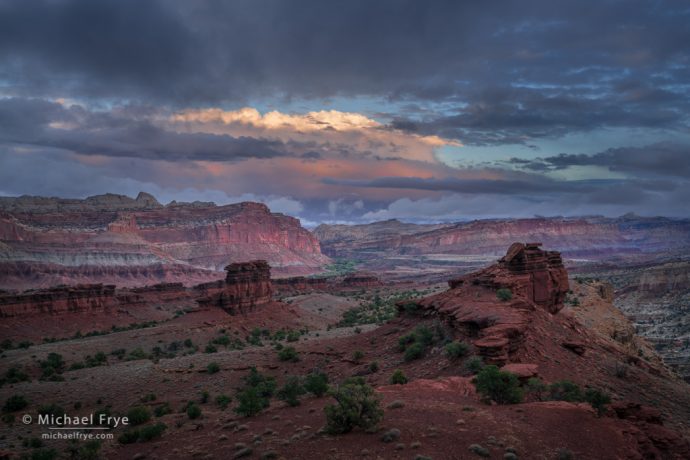
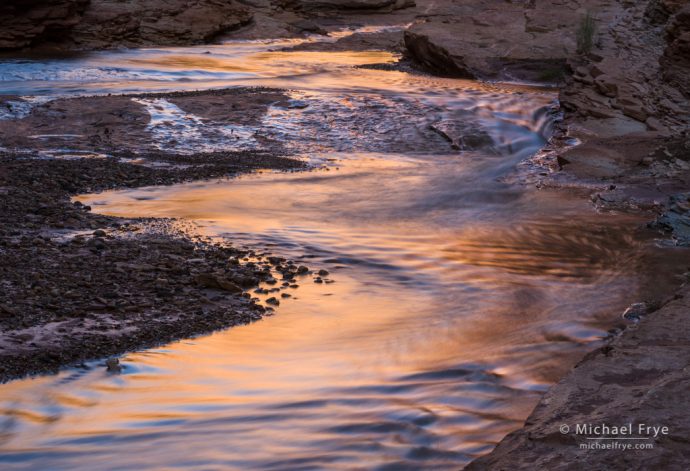
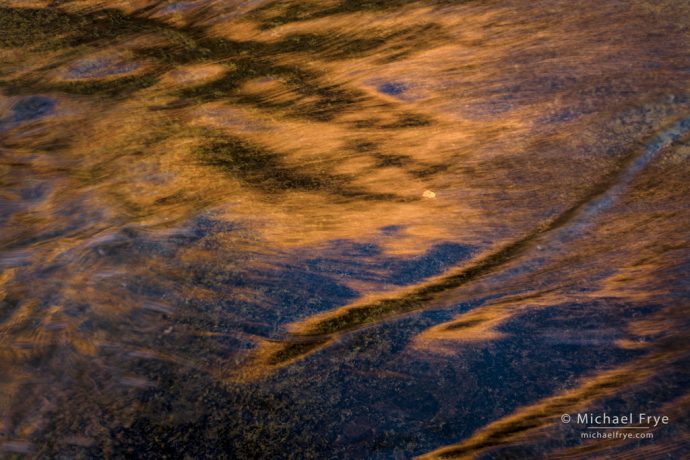
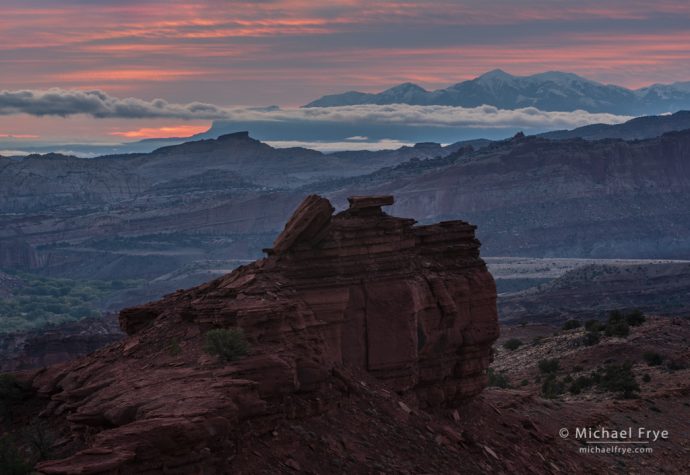
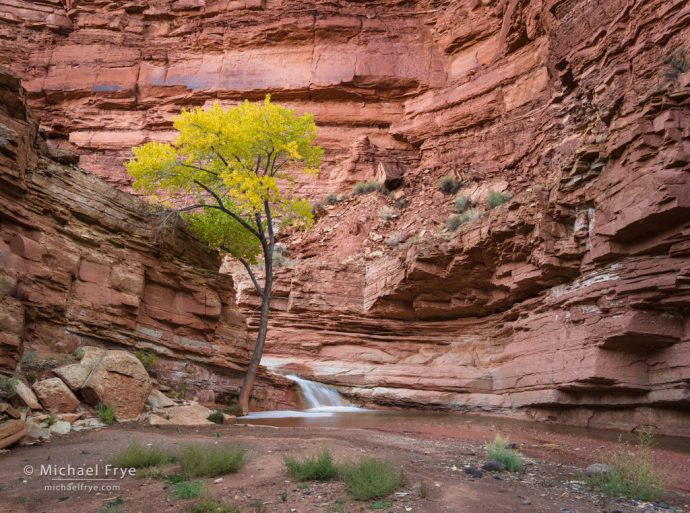
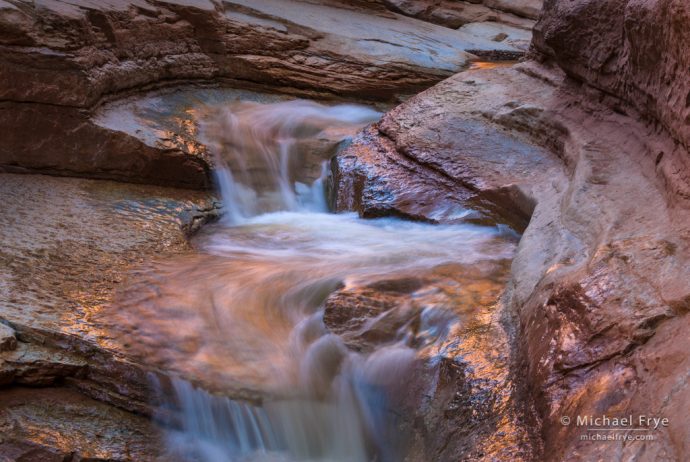








Michael, In your first “Storm Clouds at Sunset” image I love the rich but subtle color palette and how you’ve retained enough local contrast in the darker values to invite me to explore a lot of detail in the landscape. (That darker value contrast is much more evident when I view the image in the full size you’ve placed at your website.) However, my question is about how you deal with the competing elements that confuse a viewer’s brain’s ability to see a true horizontal “horizon”. I’m sure your image is truly “level”, and the upper clouds are parallel with the frame. So that’s where I start. But the lower, more distant clouds lean to the right and the uplifted geography leans to the left. Without any true vertical elements in the image to anchor on, my brain can’t settle down. That may add intrigue to the image but how do you approach this situation when composing such an photograph? And do you ever purposely tilt an image with a confusing element such as a distant shoreline that is receding at an angle, so that it appears more “level” even though it isn’t?
Thanks Howard – I’m glad you like that photograph. The image doesn’t seem tilted to me, but then I was there. Note that the little green area near the center looks flat, as it should.
But to answer your larger question, I never, ever, ever purposely tilt the photograph to make an image “look” level, because when you do that I’ve found that it never does look level. Your brain is really good at figuring out when things are level, and can tell when something is off. With your example, for instance, if you try to make the distant, receding shoreline “straight,” then trees will be leaning, and the water will look like it’s tilted and defying gravity.
Beautiful imagery, Michael! Utah is awesome, it’s definitely on my bucket list. 🙂
Thank you Gabor. If you haven’t been to Utah yet you must go!
Once Again Michael, Your Images Are Very Beautiful, “Excellent Photography”
Thank you John!
Love your work- all of it fabulous!
I hike to photograph the “wild side” of the Vegas area. I had 35 mm lens in every size and several cameras but obviously I need to purchase a small digital. I can’t carry a lot of weight (back is getting old) but want a lens worthy of the landscapes. Any suggestions? TIA
Thanks Diana! As for your question, I generally don’t give out advice about what camera or lens to buy, as everyone has different needs, and I’m not an equipment geek and don’t know half of what’s available, nor the pros and cons of any of it.
Storm clouds is powerful image – an icon of Capitol Reef. Is this image available?
Thanks Phil – I’m glad you like that image. Pretty much everything I post here is available as a print; you can see sizes and prices here:
https://www.michaelfrye.com/portfolios/print-ordering/
Yep, Guy Tal and Michael Frye!!! Two of my favorites for finding and capturing that one elusive moment in our time journey! These are all beautiful !!!
Thank you Anne!
Really enjoyed these photographs.
I know its controversial, but is there some way we could get, or you could include, some of the exif data. I would find it very educational.
Looking forward to your next submission,
Regards, Barry S.
Thanks Barry. There’s no good way for me to automatically include the EXIF data. When it seems relevant I add it to the captions. It didn’t seem particularly relevant here. Why do you say it’s controversial?
Thanks so much for responding.
I’ve gotten the impression that some photographers are getting irritated when often asked for their settings and equipment choices. I believe they feel people are getting caught up too much in the technical details and not developing their own technique and composition skills. While I can understand this I personally enjoy viewing photos I admire and testing my ability to “see” the lens choice and exposure settings the photographer might have chosen. Sometimes I get it wrong and learn new approaches. For instance, I am using more telephoto lenses in my landscapes than I ever did in the past.
Regards, Barry S.
Well I agree with “some photographers” who feel that people get too caught up in the technical details. Maybe more to the point, some people draw erroneous conclusions from the bare bones information about shutter speed, aperture, and ISO. When divorced from any context – like the amount of light, or whether the wind was blowing, or how the photographer arrived at a particular exposure, or what the scene would have looked like with a different lens – that EXIF data is, I think, at best not very useful, and at worst misleading and counter-productive. It sounds like you’re able to take that information and put it to good use, but unfortunately I think you might be an exception. I suspect that such out-of-context information is less likely to be misinterpreted by advanced photographers, who already have a pretty good idea of what they’re doing technically, and can take an educated guess about why a photographer chose certain settings. But for beginners, and even many intermediates, I think the settings need to be put in context.